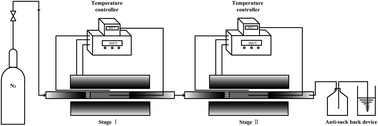Characteristics of a CaSO4 oxygen carrier for chemical-looping combustion: reaction with polyvinylchloride pyrolysis gases in a two-stage reactor
Abstract
Chemical-looping combustion (CLC), which is a promising technique that includes an inherent separation of CO2 may reduce the generation of dioxins in municipal solid waste (MSW) disposal because in a CLC system, no free oxygen is available for incineration process. Polyvinylchloride (PVC) and kitchen garbage are the main chlorine substances in MSW. The reaction between PVC pyrolysis gas and a calcium (Ca)-based oxygen carrier was investigated in a two-stage reactor in this study. The thermal decomposition and reduction/oxidation cycle behaviors of the oxygen carrier were investigated by analyzing methane (CH4) using a thermogravimetric analyzer (TGA). The characteristics of CaSO4/Fe2O3 oxygen carrier were determined by X-ray diffraction (XRD) and scanning electron microscopy (SEM). The results showed that the addition of Fe2O3 into CaSO4 can enhance the reaction rate, and also that the CaSO4/Fe2O3 oxygen carrier showed a good heat stability at the temperature of 900 °C. The reduction/oxidation cycles confirmed that the decomposition of the CaSO4/Fe2O3 oxygen carrier is usually accompanied by some side reactions. These side reactions could cause the loss of their regeneration ability. The CaSO4/Fe2O3 oxygen carrier successfully reacted with PVC pyrolysis gas in a two-stage reactor and the complete reaction ratio of mPVC to moxygen carrier is 8. The research documented herein provides a useful reference for the utilization of MSWs.


 Please wait while we load your content...
Please wait while we load your content...